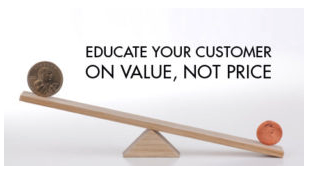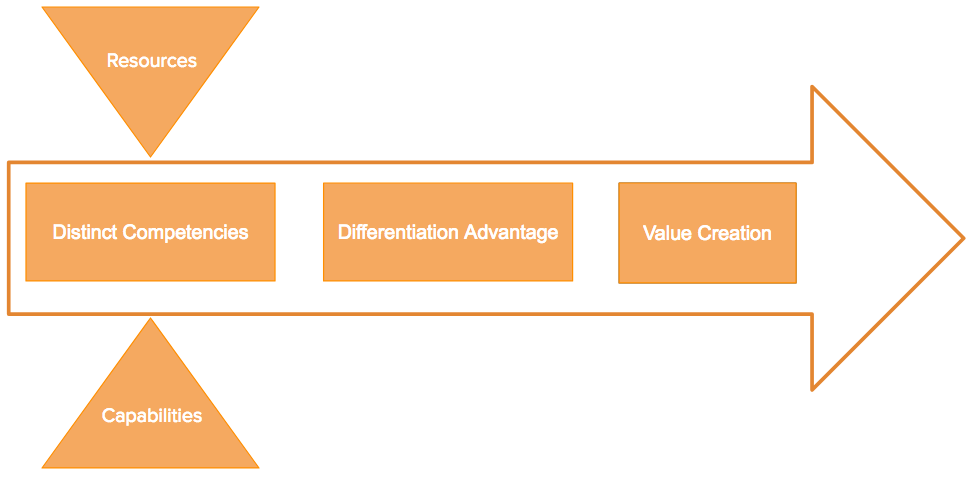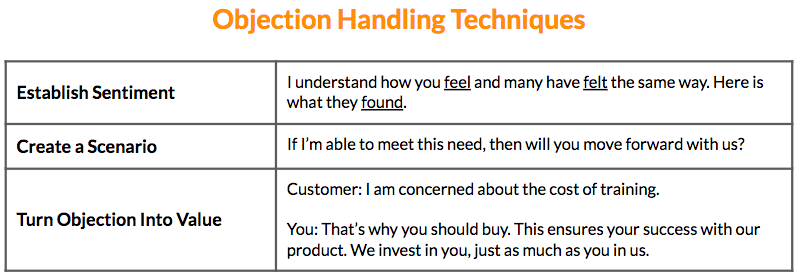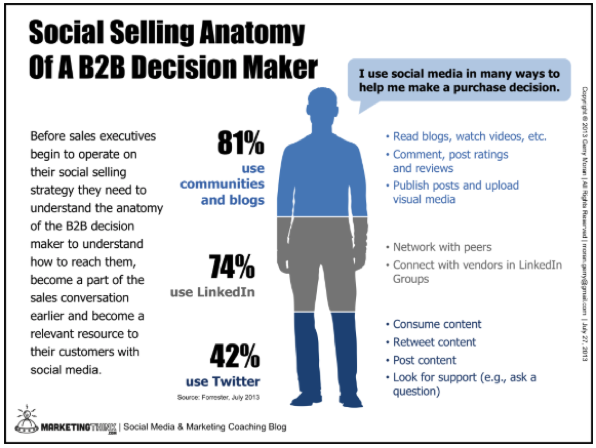The word “no” can kill your sales mojo. When you’ve poured your time, resources and heart into developing the perfect solution for your customer, a sales objection can feel like a slap in the face.
While its natural to feel a bit discouraged and defeated, most of the time, sales objections are not personal. With the right techniques, preparation, and agility, they can be easy to overcome.
In fact, the most successful salespeople are masters at handling sales objections. They get to the bottom of issues and turn them on their head to propose a solution that works for everyone.
In this article, we talk about the most common sales objections, what they may actually mean, and how to handle them so that everyone wins.
What is Objection Handling?
Objection Handling is one of the stages of salesperson during his personal selling where he has to handle certain objection and resistance of the customers. There are certain times when the customer argues and differs from the demonstration and explanation given by the salesperson to him.
Why is Objection Handling So Important for Your Sales Team?
The word objection usually has a negative connotation, but not in the case of sales! A sales objection means that the prospect is interested.
So, why do customers object?
- The customer isn’t convinced
- The customer doesn’t understand
- The customer is attempting to hide the reason (they may be bluffing to set up a better deal)
The fact that they’re talking about their concerns is your chance to prove that you have the solution they need.
The video below will walk you through the objection handling process in a play by play format.
10 Examples of Sales Objections (and How to Overcome Them)
Hearing an objection is disheartening, but you shouldn’t let it derail you from the sale. Objections should be expected and you should plan accordingly. Most are subjective to the customers initiatives.
This is where you can change their mind and shift their priorities by showing off your best features. Convince them of the value your product provides.
“It’s just too expensive.”
I’ve spent time analyzing our quarterly budget and unfortunately, we just do not have the funds to cover your service. I appreciate your time and effort and hope we can work together in the future.
While price is often cited as the reason for turning down a sale, it’s rarely the real reason. There is usually something deeper. If your customer has cited price as a reason for not moving forward in your engagement, it’s time to take a step back and ask yourself two key questions:
- Do I really understand the customer’s challenges, and have I done an excellent job showing how my solution will help them?
- Have I conveyed the value they will get from using my solution? Have I positioned it as an investment?
 If you can’t honestly answer the questions above with a resounding “yes,” you have some work to do to recover your credibility with the customer.
If you can’t honestly answer the questions above with a resounding “yes,” you have some work to do to recover your credibility with the customer.
Here are a couple tips for getting the conversation back on track.
Ask Clarifying Questions and Listen: Without discrediting the customer’s price objection, give them the opportunity to share more information.
“I understand that price is a concern. Is there anything else about my proposal that concerns you or your team?”
Once you’ve asked your question, let the customer respond. It’s important that you keep your words to a minimum; let the customer talk, and actually listen.
You want them to understand that you are genuinely interested in knowing their concerns, so that you can learn and grow from the experience. You may be surprised how much information you can uncover by giving the customer the space to speak.
Shift the Conversation: Focus on Value: If a customer is concerned with price, they don’t understand the value they can expect from your solution.
Think back to the problem the customer is trying to accomplish and ensure your proposal clearly addresses his or her needs. If it makes sense, shift the conversation from the price tag to what they’ll save or gain by using your solution in the long run.
While it’s always an option to discount, incent, or add bonus offers to your proposal, it shouldn’t be your first reaction to a price objection. It’s best to start a sales relationship by being clear about the value you bring to the table. You want to be seen as the best option, not just the cheapest option.
“We’re fine with what we have.”
My team and I have reviewed your solution and we have decided not to move forward. You have a useful product but we’re happy to stick with the solution that we’re using today.
If your customer cites complacency as the reason for not moving forward in a sale, it’s likely that they don’t understand how your solution will address their needs. In fact, they may have lost sight of the fact that they even have a problem or an opportunity.
Here are a couple steps you can take:
Remind the customer of the issue or opportunity: In most cases, they started talking to you for a reason, whether it was that they saw an opportunity, or they were experiencing issues that they thought you could address.
If they have decided your proposal is no longer a priority, your job is to remind them of the issue they were trying to solve and how your solution can help.
“I remember that you mentioned challenges with the speed of your software. Is this still an issue?”
Reinforce the competitive advantage: Successful businesses pay attention to competition to ensure they don’t fall behind. If your customer’s competitor is doing something to get ahead, your customer will likely be interested.
To grab your customer’s attention, look for opportunities to cite examples, case studies, or competitor insights, showing how similar customers have benefited from a solution like yours.

“You’re offering too much!”
We’ve reviewed your proposal and are impressed by the many aspects of your product. Unfortunately, we’re only looking to solve a single issue, and your product offers a lot of stuff we simply won’t take advantage of.
It seems counter-intuitive, but your customer may get cold feet if you’re offering a solution that exceeds their needs. In this case, the customer may be concerned with the value they’ll get from a solution that they’re underutilizing because they will only take advantage of a portion of the offering.
In these situations, your role is to clearly articulate the value they will get from your offering, even if they’re only taking advantage of a portion of it. At the same time, you can help them see the big picture by reinforcing your understanding of their business challenges and sharing ways they will be able to benefit from the other features now or in the future.
As with other objections, the best way to do this is to ask questions and listen attentively to your customer’s answers.
“The timing is not right.”
Unfortunately, we are just not ready. We just went through a major re-org and our team is going through too much change to make such a major decision. I’ll follow up with you when things settle down and we’re ready to talk again.”
Timing can make or break a deal, and sometimes your timing does not align with your customer’s timing. Unfortunately, your need to close a deal in a certain month or a certain quarter is usually irrelevant to the customer. When you’re in a situation where timing is not aligned, your job is to create and show the advantages of completing the transaction during your desired timeframe.
Ask yourself:
- Can you demonstrate what they’ll lose by putting off the sale?
- Will they miss additional profits?
- Will they continue to operate with costly inefficiencies?
- Can you incent the customer to close within your timeline?
As always, center your value on understanding what’s important to your customer. If it’s truly a tough time, pushing the customer may hurt your relationship. In this case, you’re better to serve as a trusted advisor while waiting for the right timing.
It seems counter-intuitive, but sometimes taking a short-term hit leads you to a long-term lucrative customer relationship.
“You’ve got the wrong person.”
I spoke with our Vice President of Marketing and what you’re offering is not aligned to her current priorities. I wish there was something more I could do! If something changes, we will let you know.”
If your customer is objecting based on the decision of another person, you may have a misunderstanding of your audience. This is a challenging situation as your contact may be acting as a gatekeeper, making it hard to understand the decision maker’s business issues.
Ask yourself:
- Do I understand who the decision maker is on this deal?
- Do I understand that person’s biggest challenges and opportunities?
If your answer to these questions is “no,” you have some work to do. In some cases, you may try to gain direct access to the decision maker. In other cases, it may be advantageous to focus on understanding how your solution benefits the gate keeper.
For example: Is championing your solution a good opportunity for the gatekeeper to demonstrate their strategic value to the company?
Sometimes customers will use another person’s rejection as an excuse to mask another reason for rejecting the sale. Like a price rejection, you can use this opportunity to ask questions and uncover additional information about what the customer did not like about the solution.
Regardless of the reason, proactivity is key. Instead of agreeing to wait to hear back, offer to schedule the next engagement, whether that’s prepping the gatekeeper to champion your solution or setting up a joint meeting.
“It’s too much work.”
Thanks for taking the time to walk us through your solutions. What you shared is great, however, at this time we don’t have the time to invest in the implementation. We’ll get back to you when things slow down.
The best things in life require work. If your customer is objecting due to the effort required to implement your solution, we recommend two approaches.
Focus on Knowledge and ROI: Most likely, you and your company have experience implementing your solution and have a good understanding of what it takes for successful implementation.
When discussing this with your customer, focus on data and real customer examples that can help assure them they will be able to tackle the implementation successfully with your support.
When referencing client examples, be sure to focus on success data. Share specific numbers that show that it’s worth putting in the effort. Numbers speak louder than words.
As always, asking the right questions may help the client realize that the work they put in will pay off exponentially.
For example, if your solution introduces automation, remind the customer of the long-term time savings they will enjoy once the implementation is complete.
Offer Extra Consulting and Support: When clients are concerned about implementation, sometimes all they need is extra support. In these cases, focus on consulting and implementation services that you can offer to ensure the project is a success.
You may be able offer this as an incentive, but if not, present it as a low-cost way to ensure they get a quick return on their investment.

“We’re going with the someone else.”
Thank you for the great presentation. We’ve considered all options and have decided to go with another vendor.
This may be one of the hardest objections to swallow. If your customer has decided to go with another vendor, it’s natural to feel defeated. If this occurs, your first step should be to understand why they chose the competition. Was it price? Was it features or functionality? Was it the promise of customer service and support? Did the other salesperson do a better job selling the solution?
Regardless on the reason, your job is ask genuine questions and allow the customer the opportunity to answer. It’s important in this situation that you do not come off defensive, but demonstrate that you have an open mind and are eager to hear the feedback that will help you learn and grow. You may find that you have a blind spot. Maybe you missed something that you still have the opportunity to address with the customer.
Even if there is no hope to recover this sale, your willingness to hear feedback set you up for successful future client engagements.
“I don’t know if we really need this right now.”
We have so many other pains that need to be addressed, we’re just not sure we need this solution yet.
But it is a problem, so why not solve it now? In order to persuade them to take action, it’s up to you to give them reasons why they need it now. You do this by figuring out what they care about and relating it back to how your product will help them do that.
Only 13% of customers believe a sales person can understand their needs.
“I don’t see the potential for ROI.”
You have a great product, but we don’t see how it will help us and our bottom line. Paying for a system in which we already have a work around for is not in our best interest.
This is an easy one. They just need more information but are being difficult and not asking for it. This is where you need to provide them with data and use cases.
Show that you’ve helped companies just like theirs by increasing revenue X% or saving X hours per day which has lead to a boost in productivity (which directly impacts and improves the bottom line).
“I don’t want to get stuck in a contract.”

You know they’re interested and they have a need, so finding value in your product is not the reason. This could be a sign of budget issue. Work with them to figure out a payment plan or discount offer. If you still get nowhere, try a month to month contract. Surely they can afford one month at a time? If still met with a ‘no’, it’s probably a blessing in disguise. They may not be a viable business and not worth investing your time in onboarding, support, etc. Leave on good terms and touch base occasionally because their cash flow issue may resolve down the line and they will be ready for your sale!
3 Techniques to Handle the Toughest Sales Objections
Pause.
Once the objection is aired, take a few breaths. Silence is your friends at this juncture. Digest what you have heard and craft a well thought out response.
If you immediately blurt out once they’re done talking, you look less confident and will lose credibility.
Repeat/Confirm Their Objection.
When the prospect is done talking, pause and repeat back what they just said in the form of a question.
Example; If I understood correctly, you have concern around the responsiveness of customer service, yes? Now pause and wait for their response. They will then clarify the question. Now you can put their mind at ease with the proper solution to their grievance.
The Less You Talk, The Better.
Being clear, concise, and brief demonstrates your confidence (which will put the potential buyer at ease). A confident rep portrays a valuable product. The more you blabber on, the less engaged your prospect will become.
Letting them talk shows that you care about their needs and are interested in helping find a resolution to their pain points.
Learn to love the “no” (and close the sale)
Regardless of the objection, your best bet is to manage the objection as quickly as possible, before the customer has a chance to solidify his or her answer.
To avoid being caught off-guard, be prepared. Think about possible objections and how you will handle them if they arise. When in doubt, the way forward is nearly always centered on asking good open-ended questions and listening attentively.
______
Questions or comments? Contact SPOTIO at [email protected] or comment below.
SPOTIO is the #1 field sales acceleration and performance management software that will increase revenue, maximize profitability, and boost sales productivity.
Want to see a product demonstration? Click here to see how SPOTIO can take your sales game to the next level.



